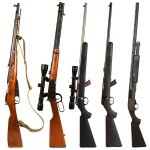 If you’re just getting into hunting and aren’t sure what gun you are in the market for, there are a number of factors to consider. Many hunters prefer shooting with a shotgun for its power and spread, advantageous for both nimble fowl and for penetrating tough buckskin alike. Still others prefer the accuracy of a rifle to the boom of a shotgun.
If you’re just getting into hunting and aren’t sure what gun you are in the market for, there are a number of factors to consider. Many hunters prefer shooting with a shotgun for its power and spread, advantageous for both nimble fowl and for penetrating tough buckskin alike. Still others prefer the accuracy of a rifle to the boom of a shotgun.
When considering a rifle, there’s more to consider than simply the caliber. For starters, there’s the action to take into account. Today you have more options than ever when it comes to selecting you action. They include Bolt, Lever, Pump and Semi Auto and vary in their degrees for allowing accuracy, steadiness and speed. Picking you action is a matter of preference after a period of trial and error.
Once you have narrowed down the action you are most comfortable with, there is the aspect to consider not everyone knows about. Some seasoned shooters swear by the rim fire option over the center fire. The mechanics of the difference between the options are much easier to break down than the subjective preference for either.
Centerfire rifles have an independent primer in the center of the brass without damaging it. However, rimfires have a primer built into the rim in the brass, which the firing pin crushes to ignite the primer. Because this is crushed and effectively damaged, rimfire options cannot be reloaded.
Shooters preferring centerfire enjoy a few advantages. Generally speaking, it is much more reliable. Furthermore, centerfire brass can be reloaded, is stronger and can withstand higher pressure. Rimfire shooters, on the other hand, enjoy a more affordable price tag. The rimfire also must be housed in a much thinner casing, which can’t stand higher pressures, such as in a 30/30 rifle, an American favorite.